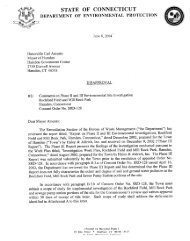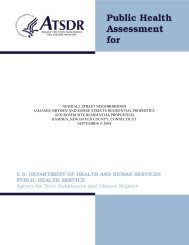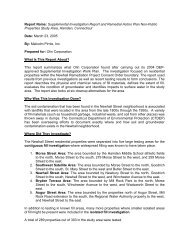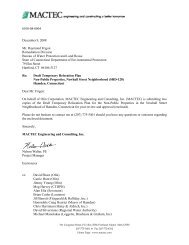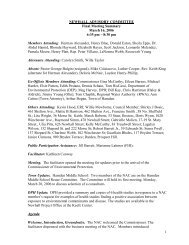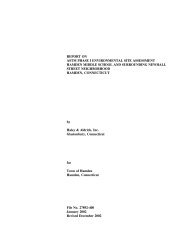Remedial Action Plan - Rochford Field - Newhall Remediation Project
Remedial Action Plan - Rochford Field - Newhall Remediation Project
Remedial Action Plan - Rochford Field - Newhall Remediation Project
Create successful ePaper yourself
Turn your PDF publications into a flip-book with our unique Google optimized e-Paper software.
3. REMEDIAL ALTERNATIVE ASSESSMENT AND REMEDIAL ACTION PLAN<br />
3.1 Regulatory Compliance<br />
In accordance with the Consent Order, Haley & Aldrich considered remedial options and alternatives to<br />
address soil and groundwater contamination at the subject site. Properties subject to a Consent Order,<br />
such as the subject site, are subject to the CTDEEP RSRs. Several RSR criteria are applicable to the<br />
site due to the presence of both GAA and GB groundwater resources. CTDEEP criteria applicable to<br />
the site soil includes; RSR RDEC, GAPMC, and GBPMC. CTDEEP RSR GWPC, SWPC, and<br />
Residential Volatilization Criteria (RVC) are also applicable to the site groundwater. During the Phase<br />
III and Supplemental Phase III investigations, Haley & Aldrich compared site soil and groundwater<br />
quality to applicable RSR criteria. Results of the site characterization detected soil containing SVOCs,<br />
ETPH and/or metals in excess of RDEC at depths ranging from less than 2 ft. to below the water table.<br />
Soils above the water table also exceeded applicable PMC at widespread locations. Groundwater<br />
beneath <strong>Rochford</strong> <strong>Field</strong> contained SVOCs, ETPH, nickel, and zinc at concentrations above RSR<br />
GWPC.<br />
Given the widespread nature and extent of impacts that exceed RSR criteria encountered on the site,<br />
remedial action will be required to achieve RSR compliance at the site. The RDEC is applicable to<br />
soils at depths up to 15 ft below grade. The RSRs allow for use of deed restrictions (known as<br />
Environmental Land Use Restrictions, or ELURs) to reduce the potential for future human direct<br />
exposure to environmentally-impacted materials. ELURs not only record the location of<br />
environmentally impacted materials exceeding RSR criteria, but also require placement of 2 to 4 ft of<br />
clean fill material over environmentally-impacted material exceeding RSR Direct Exposure Criteria<br />
(DEC). The CTDEEP requires the ELUR and the clean fill in order to render environmentallyimpacted<br />
materials “inaccessible”.<br />
In addition, environmentally-impacted material located above the water table that exceeds the RSR<br />
PMC has the potential to pollute groundwater at and down-gradient from the site. Environmentallyimpacted<br />
material that exceeds the RSR PMC will either require excavation and off-site disposal, or an<br />
engineered control (i.e., a cap designed in accordance with the RSRs). An engineered control would be<br />
used in order to make the material “environmentally isolated”. The RSRs allow for several other<br />
options to address PMC impacts including a variance due to the presence of “Widespread Polluted Fill”<br />
and determination of alternative PMC. Widespread Polluted Fill is defined in the RSRs as fill that is:<br />
not polluted with volatile organic substances; does not affect the quality of an existing or potential<br />
public or private water supply; additionally, the placement of the fill was not prohibited by law at the<br />
time of placement and the fill was not placed by the party requesting the variance. The evaluation of<br />
remedial options included the consideration of variances and ELURs as allowed for by the RSRs.<br />
3.2 Initial Screening and <strong>Remedial</strong> Feasibity Assessment<br />
As part of the Preliminary <strong>Remedial</strong> <strong>Action</strong> <strong>Plan</strong>, Haley & Aldrich considered a variety of potential<br />
remedial technologies and strategies, associated costs, and schedule. A number of remedial alternatives<br />
were eliminated during our initial screening due to their expense, ineffectiveness in treating metalimpacted<br />
soils, potential for direct exposure to neighborhood residents, or limitations due to the volume<br />
and nature of fill at the site. Potential alternatives eliminated during initial screening included:<br />
11



